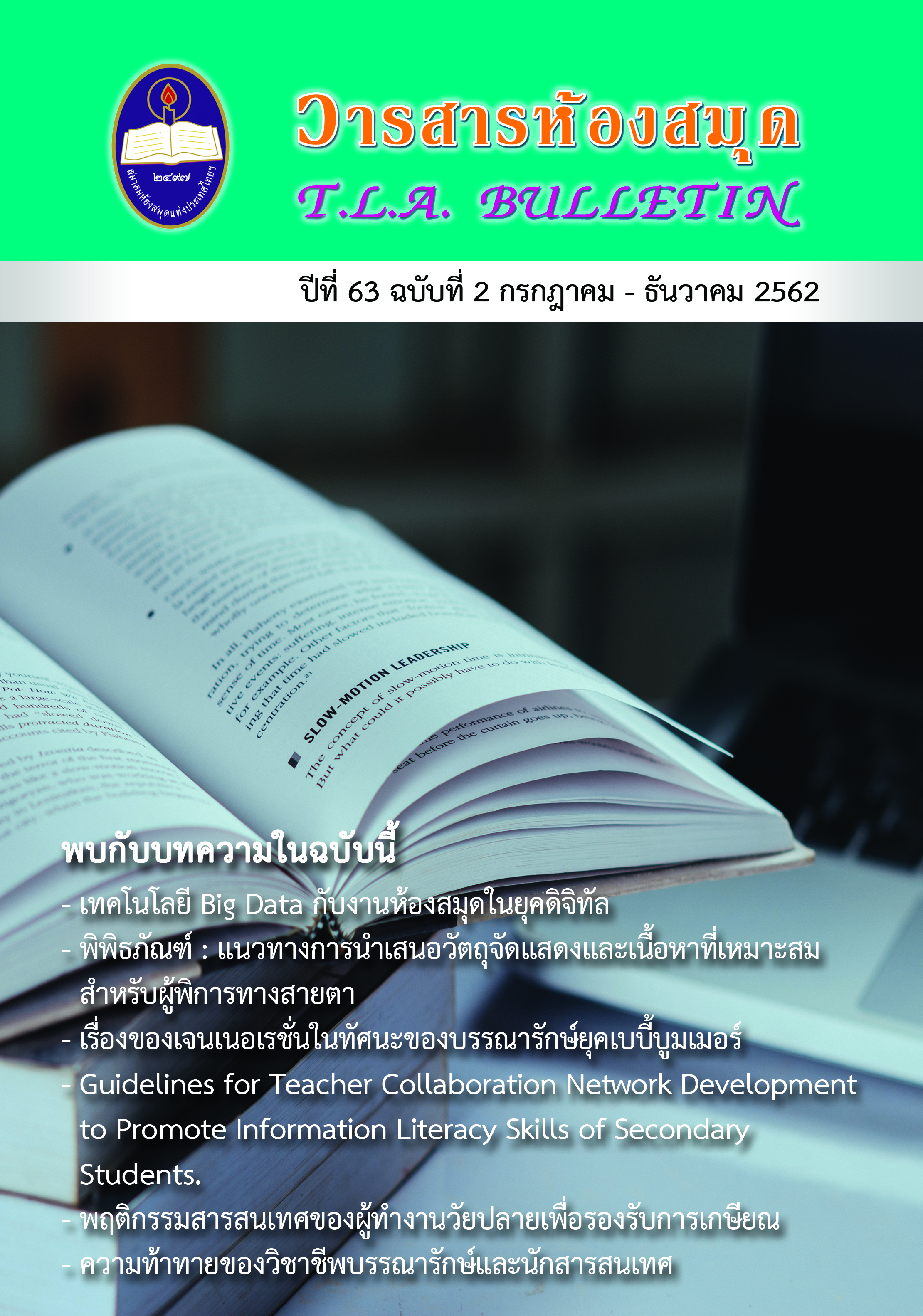พิพิธภัณฑ์ : แนวทางการนำเสนอวัตถุจัดแสดงและเนื้อหาที่เหมาะสมสำหรับผู้พิการทางสายตา
บทคัดย่อ
บทคัดย่อ
บทความนี้ได้เล็งเห็นความสำคัญของผู้เข้าชมพิพิธภัณฑ์ที่เป็นผู้พิการทางสายตา เพื่อต้องการให้บุคคลเหล่านี้สามารถเข้าถึงข้อมูล หรือความรู้ได้พอๆ กับคนปกติอย่างความเท่าเทียมกัน และเป็นการสนับสนุนการครอบคลุมทางสังคม โดยได้ทำการค้นคว้าและรวบรวมจากเอกสาร และงานวิจัยที่เกี่ยวข้องพบว่า ผู้พิการทางสายตาสามารถใช้ประสาทสัมผัสในการเข้าถึงข้อมูล คือ การได้ยิน และการสัมผัส เพื่อทดแทนการสูญเสียการมองเห็น ช่วยเติมเต็มประสาทสัมผัสการมองเห็น และสามารถสร้างจินตนาการจนเกิดเป็นวิสัยทัศน์แห่งจิตใจได้ ด้วยเหตุนี้การนำเสนอวัตถุจัดแสดงและเนื้อหาที่เหมาะสมสำหรับผู้พิการทางสายตา คือ การใช้วัตถุจัดแสดงจริง หรือจำลองตามความเหมาะสม และเนื้อหาที่นำเสนอข้อมูลด้วยการใช้รูปแบบเสียง และ/หรือสัมผัส เช่น คำบรรยายเป็นเสียง และ/หรือการพิมพ์อักษรเบรลล์ และ/หรือติดจุดเบรลล์ จะช่วยให้ผู้พิการทางสายตาสามารถเข้าถึงข้อมูลได้อย่างสะดวกขึ้น และเก็บข้อมูลไว้ในความทรงจำให้ได้มากที่สุด
คำสำคัญ: พิพิธภัณฑ์; ผู้พิการทางสายตา; วัตถุจัดแสดงและเนื้อหา; การรับรู้; ประสาทสัมผัส
Downloads
เอกสารอ้างอิง
Ariyaprasert, C., & Iamcham, V. (2013). The standard manual of content presentation of learning center in public building with universal design. Bangkok: Thai Health Promotion Foundation.
Atagök, T. (1999). Cited in Günay, B. (2012), Museum concept from past to present and importance of museums as centers of art education. International Conference on New Horizons in Education, 55, 1250-1258.
Black, G. (2005). The engaging museum: Developing museums for visitor involvement. London: Routledge.
Brstilo, I., & Jelavic, Ž. (2010). Culture as a field of possibilities: museum as a means of social integration. Ethnological Research, 15, 161-173.
Cattaneo, Z., & Vecchi, T. (2011). Blind vision: The neuroscience of visual impairment. Cambridge, MA, US: MIT Press.
Cuevas, I., & Plaza, P. (2009). Odour discrimination and identification are improved in early blindness. Neuropsychologia, 47, 3079e3083.
Deutschen Blinden- und Sehbehindertenverband e.V. (DBSV). (2011). Guidelines to ensure accessibility to museums and exhibitions for the blind and partially sighted. Retrieved 2019 October 16. URL: https://www.accessibletourism.org/resources/museums-and- exhibitions-accessible-for-visually-impaired---guidelines-20111.pdf
Dimitrova-Radojichikj, D. (2017). Museums: accessibility to visitors with visual impairment. Paper presented at the Национална научна конференция с международно участие по проект BaGMIVI на програма Erasmus+ „Достъп до изкуството на лица с нарушено зрение“, At Sofia, Bugaria.
Goldreich, D., & Kanics, IM. (2003). Tactile acuity is enhanced in blindness. J Neurosci, 23(8), 3439-3445.
Günay, B. (2012). Museum concept from past to present and importance of museums as centers of art education. International Conference on New Horizons in Education, 55, 1250-1258.
Heller, M. A. (2006). Picture perception and spatial cognition in visually impaired people. In M. A. Heller, & S. Ballesteros (Eds.),Touch and Blindness (pp. 49–71). New Jersey: Lawrence Erlbaum Associates.
Hersh, M., & Johnson, M. (2008). Disability and assistive technology systems. In M. A. H. a. M. A. Johnson (Ed.), Assistive Technology for Visually Impaired and Blind People. London: Springer.
Hetherington, K. (2000). Museums and the visually impaired: the spatial politics of access. The Sociological Review, 48(3), 444-463.
International Council of Museums (ICOM). (2017). ICOM definition of a Museum. Retrieved 2019 August 6. URL: http://archives.icom.museum/definition.html
Ludíková, L., & Finková, D. (2012). Improvement in education of people with visual impairment. Procedia - Social and Behavioral Sciences, 55, 971-979.
Majerova, H. (2017). The person in a situation of visual impairment and its perception and imagination from the qualitative viewpoint. Procedia - Social and Behavioral Sciences, 237, 751 – 757.
Museums, Archives and Libraries Council (MLA). (2000). Museums and galleries disability directory. Retrieved 2019 August 1. URL:http://www.accessibletourism.org/resources/uk_museumsand- galleries_disability_directory_pdf_6877.pdf
Notification of the Ministry of Social Development and Human Security Re: Types and Criteria of Disabilities, B.E. 2552. (2009, 29 May). Royal Thai Government Gazette. Volume 126 Supp. 77ง. Page 2-5. Retrieved 2019 July 30.
URL: http://www.ratchakitcha.soc.go.th/DATA/PDF/2552/E/077/2.PDF
Riviere, G. H. (1962). Cited in Günay, B. (2012), Museum concept from past to present and importance of museums as centers of art education. International Conference on New Horizons in Education, 55, 1250-1258.
Rombaux, P., Potier, H., Markessis, E., Duprez, T., & Hummel, T. (2010). Olfactory bulb volume and depth of olfactory sulcus in patients with idiopathic olfactory loss. Eur Arch Otorhin-laryngol, 267(10), 1551-1556.
Sacks, O. (2011). The mind’s eye. Prague: Dydbuk.
Schauble, L., Leinhardt, G., & Martin, L. (1997). A framework for organising a cumulative research agenda in informal learning contexts. Journal of Museum Education, 22(2&3), 3-8.
Silva, P. R., Farias, T., Cascio, F., Dos Santos, L., Peixoto, V., Crespo, E., . . . Teixeira, S. (2018). Neuroplasticity in visual impairments. Neurology international, 10(4), 7326-7326.
Small, J., Darcy, S., & Packer, T. (2012). The embodied tourist experiences of people with vision impairment: management implications beyond the visual gaze. Tourism Management, 33(4), 941-950.
Smithsonian. (n.d.). Smithsonian Standards and Guidelines on Accessibility. Retrieved 2019 July 30. URL: https://www.sifacilities.si.edu/ae_center/pdf/Accessible-Exhibition-Design.pdf
Sutthi, K. (2019). Guidelines on services and facilitates in learning center for people with visual impairments [Class handout]. Pipit Banglamphu Museum, Bangkok, Thailand.
Vaz, R., Fernandes, P. O., & Rocha Veiga, A. C. (2018). Designing an interactive exhibitor for assisting blind and visually impaired visitors in tactile exploration of original museum pieces. Procedia Computer Science, 138, 561-570.
Voss, P., & Zatorre, R.J. (2012). Occipital cortical thickness predicts performance on pitch and musical tasks in blind individuals. Cereb Cortex, 22(11), 2455–2465.
Weisen, M. (2008). How accessible are museums today? In H. J. Chatterjee (Ed.), Touch in museum. Policy and practice in object handling (1 ed.). Oxford-New York: Berg.
Wong, M., Gnanakumaran, V., & Goldreich, D. (2011). Tactile spatial acuity enhancement in blindness: evidence for experience-dependent mechanisms. Journal of Neuroscience, 31(19), 7028-7037.




